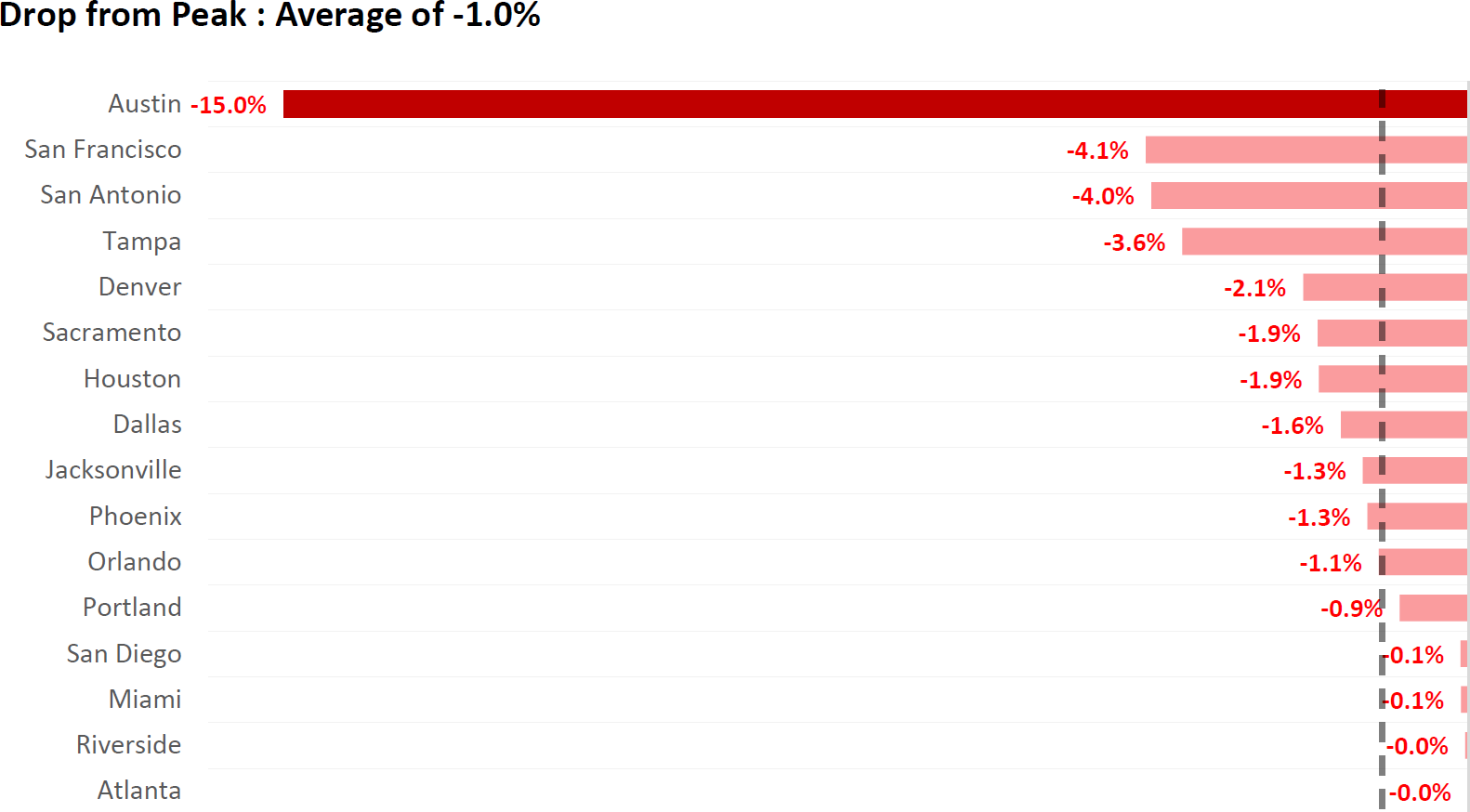Austin Home Prices Down 15%: Latest Freddie Mac FMHPI® June 2025 Update
Published | Posted by Dan Price
Austin Housing Market Correction Deepens: June 2025 Freddie Mac House Price Index Update
The latest data from the Freddie Mac House Price Index (FMHPI®) confirms that the Austin housing market continues to undergo one of the most significant price corrections in the nation. As of June 2025, home values across the Austin-Round Rock-Georgetown metro area have declined 15.0% from their peak in May 2022, extending a price adjustment that now ranks as the largest among the 40 major U.S. markets tracked by Freddie Mac.
While sharp, this market shift is not unexpected. Austin experienced some of the fastest price growth in the country during the pandemic, fueled by an influx of remote workers, tech industry expansion, and historically low interest rates. But as affordability weakened, inventory surged, and mortgage rates climbed, the market began to cool—first slowly, now more decisively.
According to the latest FMHPI data, Austin home prices are down 5.4% year over year, with a 2.8% month-over-month decline, reflecting continued softening. Yet despite these near-term corrections, it’s important to keep a broader perspective. Home values in Austin remain 41.2% higher than they were in January 2020, and 18.7% higher than January 2021, highlighting the long-term price growth still present in the market.
How Austin Compares to Other Major U.S. Markets
The FMHPI provides a standardized way to compare price movements across different regions by analyzing conventional, conforming mortgage transactions. This approach eliminates distortions from off-market sales, non-standard financing, or fluctuations in listing practices, offering a reliable view of home price trends.
Austin’s 15.0% price decline from peak stands in sharp contrast to many other major metro areas, where prices have remained stable or even grown. For example, Chicago home prices are up 19.4% from May 2022, while New York has gained 21.8%, and Milwaukee has seen a 21.0% increase. Closer to home, markets like Dallas and Houston have seen modest declines of 1.6% and 1.9%, respectively—still far less severe than Austin's correction.
These differences reflect how localized economic conditions, affordability factors, and inventory levels influence market performance. Austin’s rapid run-up during the pandemic left more room for a correction, and the current data suggests the market is still working through that process.
What This Means for Buyers, Sellers, and the Market Outlook
For buyers, the current environment presents opportunities. Price softening, combined with elevated inventory levels, offers more choices and negotiation leverage. However, persistent affordability challenges remain, particularly for first-time buyers navigating higher interest rates and stricter lending standards.
For sellers, understanding these price dynamics is critical. Gone are the days of aggressive bidding wars and double-digit annual appreciation. Instead, strategic pricing, property preparation, and market awareness are essential for attracting qualified buyers in a more competitive environment.
While the market correction has been steep, it reflects a broader rebalancing, not a collapse. Austin remains one of the fastest-growing metro areas in the country, with strong long-term fundamentals driven by job growth, population expansion, and economic diversification. As affordability improves and mortgage rates stabilize, the market is expected to find a more sustainable footing.
At Team Price Real Estate, we believe reliable, data-driven information is the foundation of good real estate decisions. That’s why we monitor the FMHPI and dozens of other key indicators to help our clients and agents stay ahead of market trends. With over 700 pages of regularly updated reports covering the Austin area, we are proud to be the leading source of Austin real estate market data.
FAQ: Austin Housing Market and the Freddie Mac House Price Index – June 2025
What is the Freddie Mac House Price Index?
The FMHPI is a national, state, and metro-level index that tracks single-family home price changes using Freddie Mac’s conventional, conforming mortgage portfolio. It provides month-over-month, year-over-year, and from-peak performance data, offering a consistent view of market trends over time.
Why is Austin’s price decline the largest among major metros?
Austin saw some of the fastest price appreciation during the pandemic, driven by tech growth, migration, and low rates. As conditions normalized, the market corrected sharply. Prices are now down 15.0% from their 2022 peak, reflecting this rebalancing.
Are prices still higher than before the pandemic?
Yes. Despite the recent decline, Austin home prices remain 41.2% higher than January 2020 levels and 18.7% higher than January 2021, showing how much long-term growth remains in the market.
How does this impact buyers and sellers today?
Buyers have more options and bargaining power, but affordability remains tight. Sellers need to price strategically and understand that the market has shifted away from the rapid growth seen during the pandemic years.
Where can I find the most reliable Austin housing market data?
TeamPrice.com is your best source for Austin housing market insights. With extensive reports, interactive tools, and up-to-date market tracking, we provide the data and expertise you need to make informed real estate decisions.

Request Info
Have a question about this article or want to learn more?


